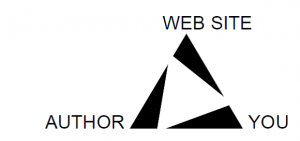The first goal was to find a symbol for the game’s title page as well as the website, a simple image was necessary so a Google search for a magnifying glass was done. a magnifying glass was chosen because it is a tool often used for taking a closer look at things, which is what source evaluation actually requires. The chosen result was this  picture of an orange 3D figure holding a magnifying glass courtesy of Flickr.
picture of an orange 3D figure holding a magnifying glass courtesy of Flickr.
The next goal was to find to find a source that would give a good description of sources and preferably something in Personal data form (PDF) so that it could be uploaded onto the Open lab “my project section”. The first attempt was a database search; academic search complete proved to be too technical; technical was great but simple was needed for this task. So Google was the next choice, the keyword search used was “correct research paper sources”. After browsing through a couple of results, one result titled “writing the research paper” it seemed a bit old since it was published in 2002 but it was from an “Edu” website and in a PDF so it had to be looked at. After opening the PDF and skimming through the reading although it was published in 2002 it was still quite relevant. It gave a description of source materials and it had this picture  that could be used to help individuals evaluate websites.
that could be used to help individuals evaluate websites.
Next was finding a source that would set the criteria to help students judge the sources that they would evaluate in the game. For that we recalled a class exercise regarding the evaluation of sources; in this exercise we evaluated sources based on currency, accuracy and relevancy. This helped form the basis of the search, a PDF was still the preferred format. The Google keyword search was “evaluating sources using currency, accuracy” the source we needed was the very first result on the page and it was from an Old Dominion university module reading on evaluation criteria, it referenced something called a CRAAP test which caught our attention. CRAAP was an acronym for currency, relevance, authority, accuracy and purpose this acronym leaves a lasting impression and is silly enough for a freshman or anyone to remember.
For the next part of the project we needed to find some examples of good and bad sources but before finding those sources we needed to better clarify what a bad source was. For that we googled “examples of bad sources” the second result from that search sufficed it was an about education reading titled “5 Bad Research Sources” which gave us some good examples of bad sources. Then we moved on to tracking down those bad sources, the about education reading mentioned movies being a bad source, which seemed interesting. This led to us choosing a movie called “Rise of the Planet of the Apes (2011)” which was a science fiction film; a Google search was performed for the movie, IMDB (internet movie data base) produced an image with the 20th century fox copyright information, the link was sent to an email account because IMDB would not allow us to copy the image from their website. Another bad source came from performing a keyword search on Google for “good and bad sources” which yielded the Prezi.com website that showed a scrolling interactive web which contained a link to a website called dihydrogen monoxide research division. This site perfectly depicted the danger of the internet allowing individuals to self-publish their own content; the last example also needed a water molecule picture which was found on Google simply by typing “H2O” and doing an image search.
When it came to the presentation we decided to go with PowerPoint to showcase the demo of the project. For getting some of the pictures and a web page into the presentation the links were sent to an email account, they were later accessed with an iPad and then screenshotted. Once the screen shot was taken it was sent back to the same email account (as an image only), where it could be copied or inserted into the PowerPoint.This was the case for the IMDB Rise of the planet of the apes photo because IMDB doesn’t allow individuals to copy the images from their website so to circumvent that rule a screenshot had to be taken but don’t worry credit was still given for the source. For the Dhmo.org web page the same process was applied because it was important to capture it in its entirety. After getting the pictures into the presentation they were cropped to erase the iPad Wi-Fi connectivity, battery percentage symbols and the time from the image. The next process was making the buttons on the presentation active for that a hyperlink from slide to slide was inserted on to the buttons.
One suggestion we can offer is to make sure when creating the project that the group has a concrete idea in mind for the concept of the project. Ours kept changing because in the beginning we were not too sure of what our project would be or we kept finding better sources which kept altering our ideas. Our advice would be to brainstorm your ideas and to outline what you want to do because it will help to follow a clearer path.


